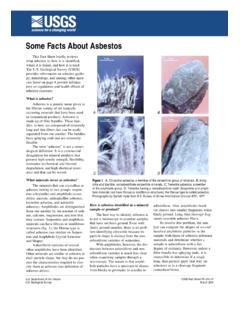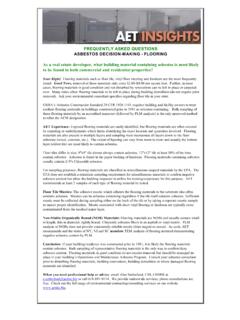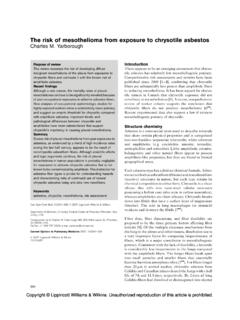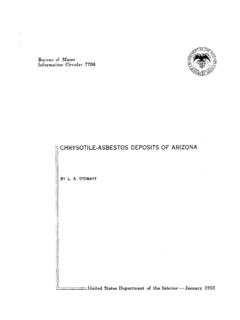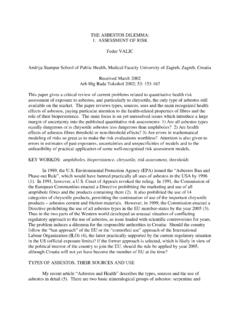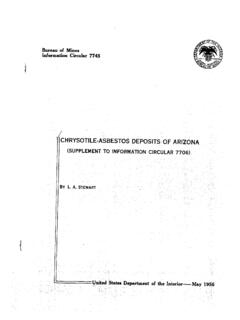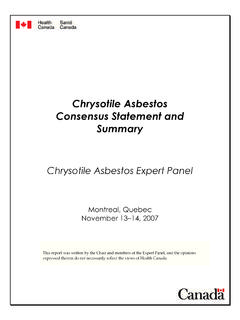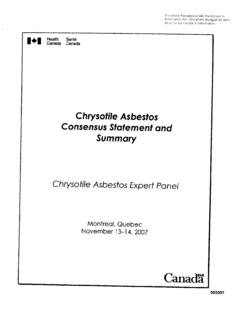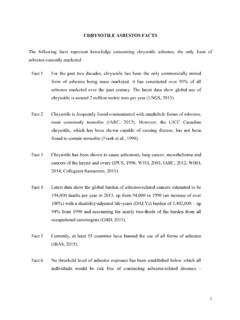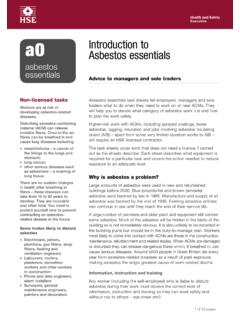Transcription of Preliminary Information on Manufacturing, Processing ...
1 Page 1 of 15 February 2017 Office of Chemical Safety and Pollution Prevention EPA Preliminary Information on manufacturing , Processing , Distribution, Use, and Disposal: asbestos CASRN: 1332-21-4 February 2017 Support document for Docket EPA-HQ-OPPT-2016-0736 Page 2 of 15 This document provides a Preliminary public summary of available Information collected by EPA s Office of Pollution Prevention and Toxics (OPPT) in the Office of Chemical Safety and Pollution Prevention (OCSPP) on the manufacturing (including importing), Processing , distribution in commerce, use, and disposal of this chemical. This is based on existing data available to EPA, including Information collected under the Chemical Data Reporting rule, Toxics Release Inventory, Information from other Agency databases, other Government agencies, publicly available Information from states, and a review of published literature.
2 In addition, the document includes Information reported to EPA by producers and users of the chemical in the United States and in other countries. This Preliminary use Information and any additional use Information received in the docket by March 15, 2017 will inform efforts to develop the scope of the chemical risk evaluation required under section 6(b)(4) of the Toxic Substances Control Act, and will inform any risk management efforts following risk evaluation. Mention of trade names in this document does not constitute endorsement by EPA. To verify products or articles containing this chemical currently in commerce, EPA has identified several examples. Any lists are provided for informational purposes only. EPA and its employees do not endorse any of the products or companies.
3 This document does not contain confidential business Information (CBI). Page 3 of 15 TABLE OF CONTENTS TABLE OF CONTENTS .. 3 CONTACT .. 3 manufacturing , Processing , DISTRIBUTION, USE AND DISPOSAL .. 4 1. manufacturing (INCLUDING IMPORTING) .. 4 2. Processing .. 6 3. PRODUCTS AND ARTICLES .. 6 4. DISTRIBUTION (INCLUDES RETAILERS) .. 8 5. USE .. 8 Use at Industrial Sites .. 9 Commercial Uses .. 9 Consumer Uses .. 9 6. DISPOSAL OF WASTE AND RECYCLING/RECOVERY .. 9 Recycling and Recovery .. 9 Disposal of Waste .. 10 USEFUL TYPES OF Information .. 11 APPENDIX: SOURCES CONSULTED .. 12 LIST OF TABLES Table 1. List of asbestos -Containing Products Currently Available for Purchase on the Internet .. 7 CONTACT Robert Courtnage, Associate Chief, Fibers and Organics Branch, National Program Chemicals Division Office of Pollution Prevention and Toxics, 202-566-1081, Docket: EPA-HQ-OPPT-2016-0736 Page 4 of 15 manufacturing , Processing , DISTRIBUTION, USE AND DISPOSAL 1.
4 manufacturing (Including Importing) As a naturally occurring mineral, asbestos is manufactured by mining, but asbestos has not been mined (or manufactured) in the United States since 2002 (Flanagan, 2016). For the 2016 Chemical Data Reporting (CDR) period, two companies reported importing asbestos in 20161, 2. These companies, Axiall Corporation and Olin Corporation, belong to the chloralkali industry. The imported amounts cannot be disclosed due to company claims of Confidential Business Information (CBI). The United States Geological Survey (USGS) produces an annual report on asbestos known as the Minerals Yearbook (Flanagan, 2016). USGS also published a Mineral Commodity Summary in 2017 (USGS, 2017). USGS analyzes and provides summaries of asbestos data, including data from the Census Bureau.
5 According to USGS, in 2016, the United States imported 340 metric tons of raw chrysotile asbestos 95% of which was imported from Brazil and 5% imported from Russia (USGS, 2017). USGS also estimates that imported products containing asbestos were valued at $ million in 2015 (Flanagan, 2016). The below asbestos product categories presented by USGS in their Minerals Yearbook are from the Harmonized Tariff Schedule (HTS), which exporters use to identify shipments. The amount of asbestos in specific products is unknown. It is also noted by USGS that product shipments in some cases may have been misclassified by exporters as asbestos -containing products. The asbestos -containing product categories include: asbestos -cement Crocidolite products (except footwear) Clothing (except footwear) Paper, millboard, and felt Compressed asbestos fiber jointing Other fabricated asbestos fibers Yarn and thread 1 Manufacturers (including importers) are required to report under CDR if they meet certain production volume thresholds, generally 25,000 lb or more of a chemical substance at any single site.
6 Reporting is triggered if the annual reporting threshold is met during any of the calendar years since the last principal reporting year. In general, the reporting threshold remains 25,000 lb per site. However, a reduced reporting threshold (2,500 lb) now applies to chemical substances subject to certain TSCA actions. 2 Manufacture means to manufacture, produce, or import for commercial purposes. Manufacture includes the extraction, for commercial purposes, of a component chemical substance from a previously existing chemical substance or complex combination of chemical substances. (40 CFR ) Cords and string Woven or knitted fabrics Products for use in civil aircraft Gaskets, packing, and seals Building materials asbestos articles not elsewhere specified Brake linings and pads, civil aircraft Page 5 of 15 Brake linings and pads, other Other friction materials, civil aircraft Other friction materials According to the USGS 2015 Minerals Yearbook, asbestos -containing products are imported from the following countries.
7 Belgium Brazil Canada China El Salvador Germany Italy Japan Israel Mexico Norway Peru Spain Switzerland Taiwan United Kingdom According to the USGS all of the current raw asbestos use in the United States occurs in the chloralkali industry, which uses chrysotile asbestos to manufacture semipermeable diaphragms for use in the chlorine and caustic soda production process (USGS, 2017). During a meeting with EPA in January 2017, industry representatives stated that in the United States, there are three companies who own a total of 15 chloralkali plants that continue to manufacture and use chrysotile -containing semipermeable diaphragms onsite. As described by the industry representatives, the asbestos for these diaphragms is imported in sealed containers, with the asbestos in sealed bags made of dust-proof, woven plastic.
8 After arriving at the plant, the sealed bags are placed inside a glove box. A trained operator removes the asbestos and puts it in a caustic bag where it becomes wet. Once wet, binding agents are added to the caustic bag to allow for handling and storage in dry form. A vacuum is then used to remove the material from a bath where it is placed into an oven and the asbestos fuses to the diaphragm. Industry representatives stated during meetings with EPA that a standard-sized manufacturing cell will have a surface area of 70 meters square (m2) and each cell will typically have 20 chrysotile asbestos diaphragms within it, although cell size can vary. The cell will typically operate for 1-3 years before it has to be replaced due to a loss of conductivity.
9 Many factors can determine the life of a cell, including the brine quality and the size of the cell. When the diaphragm cell is replaced, the asbestos is pulled out, remaining in a wet state, sealed into containers, and sent to a landfill that accepts asbestos -containing waste per federal and state asbestos disposal regulations. EPA s Regulatory Impact Assessment for the 1989 asbestos Ban and Phase-out rule also provides a description of the processes used with the asbestos diaphragms: asbestos diaphragms are prepared at the chlorine plant site itself and are not available as pre-manufactured products ready for use. In the diaphragm forming process, a slurry of asbestos in water is drawn through a screen or perforated plate by vacuum techniques.
10 asbestos fibers are deposited on the screen, or plate, forming a paper-like mat approximately an eighth of an inch thick. Page 6 of 15 EPA 1989. Regulatory Impact Analysis of Controls on asbestos and asbestos Products, Final Report, Volume III, Appendix F. Office of Toxic Substances. January 19, 1989. Geological Survey, 2017, Mineral commodity summaries 2017: Geological Survey, 202p. Retrieved from Flanagan, D. M. (December, 2016). asbestos . Geological Survey 2015 Minerals Yearbook. Retrieved from About CDR: 2. Processing EPA does not have Information pertaining to asbestos Processing , as defined under the Toxic Substance Control Act (TSCA) 3. 3. Products and Articles In addition to chloralkali diaphragms, asbestos -containing products remaining in use within the United States include some roof and non-roof coatings, gaskets, brake blocks and aftermarket friction products, most of which are imported.










